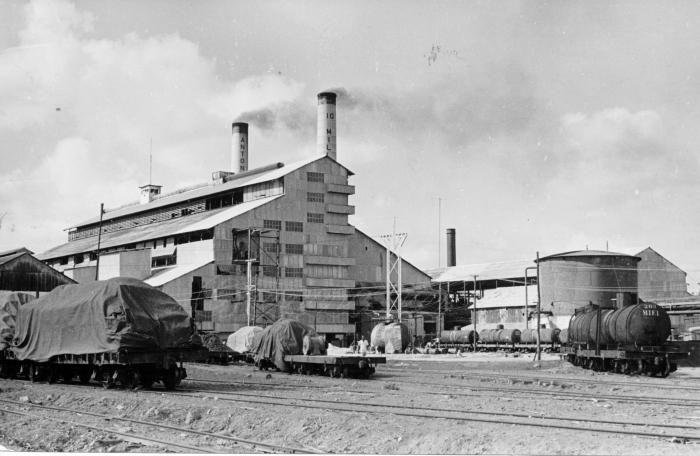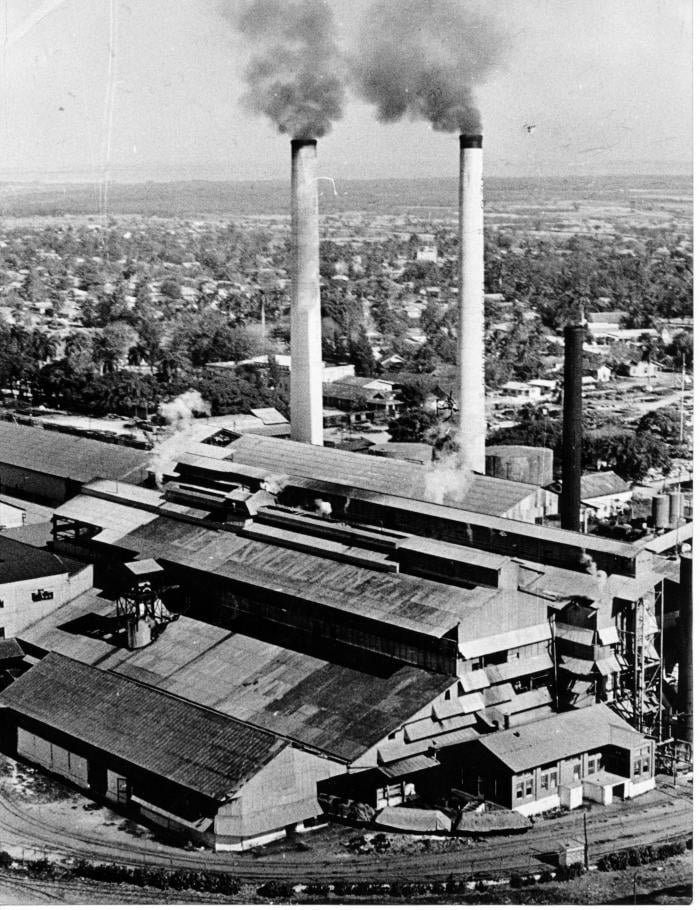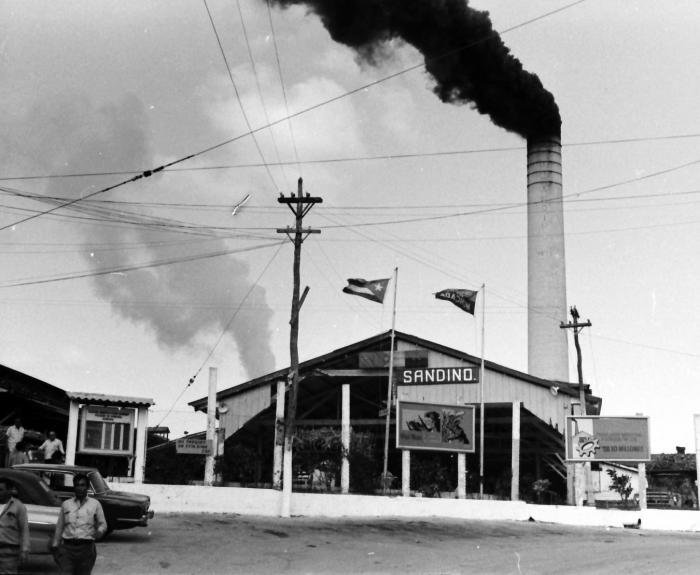
Cuban-American Sugar Co.
Born in Memphis, TN where he survived the Civil War years, Robert Bradley Hawley (1849-1921) moved to Galveston, TX in 1870 where he went in business as a merchant and in 1896 became Galveston's first Republican Congressman. After getting acquainted with the sugar business by having an ownership interest in the New Iberia Sugar Co. of Louisiana, in 1899 Hawley's participated in the US expansion of the Cuban sugar industry in a significant way. On July 26, 1899 Hawley incorporated the Cuban-American Sugar Co. in New Jersey and that same year made its first sugar mill acquisition, Central Tingüaro. He quickly moved to acquire Hacienda Chaparra from Spanish immigrant from Catalonia Antonio Mahiquez. Both Central Tingüaro and Hacienda Chaparra were located in the Matanzas Province and were devastated during the Cuban War of Independence.
On September 19, 1906 papers were filed to change the name of the Cuban-American Sugar Co. to the Tingüaro Sugar Co. That same day, the Cuban-American Sugar Co. was reincorporated in New Jersey as a holding company with authorized capital of $12 million. As a holding company, it owned all the outstanding shares of several companies that owned sugar mills in Cuba: the Chaparra Sugar Co. owner of Central Chaparra, the Tingüaro Sugar Co. owner of Central Tingüaro, the Cuban Sugar Refining Co., the Unidad Sugar Co. owner of Central Unidad, the Mercedita Sugar Co. owner of Central Mercedita and the San Manuel Sugar Co. owner of Central Delicias.
In the March 15, 1921 Trust Agreement for a US$10 million bond issue, the Cuban-American Sugar Co. listed 100% ownership of several subsidiaries, all organized under the laws of the State of New Jersey. Each subsidiary's main asset, held free and clear of all encumbrances; Chaparra Sugar Co., Chaparra Railroad Co., San Manuel Sugar Co., Tingüaro Sugar Co., Mercedita Sugar Co., the Colonial Sugars Co. and Colonial Sugar Refinery in Louisiana. The sugar mills owned by the Cuban-American Sugar Co. were the following. The Cuban American Sugar Co. also owned Cuban Sugar Refining Co., a sugar refinery in Cárdenas Matanzas Province, the only remaining sugar refinery in Cuba from the pre-war for independence years.
Central Unidad - Was established in Calabazar de Sagua Santa Clara Province in the 1860s by American John McCulloch and later his estate who owned it until 1906 when it was acquired by the Cuban-American Sugar Co. It was sold in October 1942 to Azucarera Central Unidad S. A. owned by Spaniard from the Basque Country Mamerto Luzárraga Echevarria who arrived in Cuba in 1888 and was also owner of Central Portugalete in Santa Clara/Las Villas Province which was his first sugar mill purchased in 1940.
Central Chaparra - The Chaparra Sugar Co. owner of Central Chaparra was incorporated in New Jersey on October 18, 1899 with a capital of $1 million. Its incorporators and principal shareholders were Robert Bradley Hawley, President; Frederick H. Howell (1848-1929), Vice President and James Howell Post (1859-1938), Treasurer. In 1901, the company entrusted Cornell University School of Engineering graduate Gen. Mario Garcia Menocal (1866-1941) to design and build the Central Chaparra on the grounds of the old Hacienda Chaparra at Puerto Padre built in 1894 but destroyed during the Cuban War of Independence after only one year in operation. When finished in time for its first grinding season in 1902, it was the largest sugar mill in the world with daily grinding capacity of 9,100 tons of sugarcane. It was managed by Gral. Mario Garcia Menocal was its manager together with Central Delicias until 1911 when he left to be the President of Cuba. It was owned until 1960 when the company was nationalized by the Fidel Castro regime.
Central Delicias - In December 1909 the Cuban-American Sugar Co. organized the San Manuel Sugar Co. to buy the old Ingenio San Manuel from Francisco Plá Martínez Picabia son of its founder José Plá. Part of its machinery was moved to the banks of the Chorrillo River (now Rio Santo Domingo) near Puerto Padre where the new and modern sugar mill named Central Delicias was to be erected. In 1910, under the direction of Gral. Mario Garcia Menocal, construction began using what was available from the dismantled Central San Manuel. As a subsidiary of the Cuban-American Sugar Co., the San Manuel Sugar Co. began operations in 1911 with a daily grinding capacity of 11,700 tons of sugarcane, surpassing that of Central Chaparra. In 1952 Central Delicias produced 1,383,653 bags of sugar, a world record. Prominent investors in the reorganized company were James Howell Post and Thomas A. Howell president and vice president of the National Sugar Refining Co., B. H. Howell Son & Co., Bunker & Mollenhauer Sugar Refining Co., Lorenzo D. Armstrong and John Farr and received financial support from Henry O. Havemeyer. It operated as a subsidiary of the Cuban-American Sugar Co. for forty nine years until 1960 when it was nationalized by the Fidel Castro regime.
Central Tingüaro - Was established in 1840 by Francisco Diago, it was inherited by his daughter Maria Luisa Diago who while at the time living in Spain sold it in 1877 to German immigrant from Bremen Carlos Rossum whose las name was changed to Spanish as de la Rosa. In 1899 Carlos Rossum sold it to middleman Ignacio Valor who immediately turned around and sold it the Cuban-American Sugar Co. On January 20, 1943 a fire destroyed Central Tinguaro and the company decided not to rebuild although the Cuban government insisted they did. That being the case on September 24, 1943 the government took over the sugar mill, rebuilt it and ran the 1943-1994 grinding season. On March 13, 1944 it was sold to Julio Lobo for $1,65 million of which $250,000 went to the government for the rebuilding costs.
Central Mercedita - Located in Cabañas Pinar del Río Province, was originally established in 1874 by Spanish immigrant Santiago de la Cuesta in partnership with Juan Grancisco Santiago-Aguirre y Olivara son of Spanish immigrants. It was owned until 1960 when the company was nationalized by the Fidel Castro regime.
Central Constancia - Was established in 1857 by Spaniard from Navarra Martin Felipe de Apezteguía y Apasecha who was married to Josefa Mariana Tarafá Mechín, daughter from an out of wedlock relationship of José Magín Tarafá Baseras and Victoria Agata Mechin y Courreur and therefor aunt of José Tarafá Armas. In the mid 1890s the Constancia Sugar Co. was under the control of its major creditor, the Wall Street firm Perkins & Welsh who in 1901 foreclosed on its mortgage to Julio de Apezteguía y Tarafá, son of its founder Martín Felipe de Apezteguía y Apecechea. Backed by capital from Louisiana and the Illinois Central Railroad, in 1922 the Colonial Sugars Co., incorporated in 1902 to take over the Gramercy Sugar Co., organized in 1895 by a group of investors from New York to operate the Colonial Sugars Refinery in St. James Parish, Louisiana and then a subsidiary of the Cuban-American Sugar Co., purchased Central Constancia Sugar Co. and its Central Constancia which it operated until December 20, 1949 when it was sold to Francisco Blanco and dictator Fulgencio Batista under the name Rancho Veloz Sugar Co. The Colonial Sugar Co. as a subsidiary of the Cuban-American Sugar Co. ran the refinery until 1971 when it was acquired by LSR, LLC.
In 1933, labor unrest, strikes and daily violence were the order of the day throughout Cuba. During that year's dead season, the Cuban government of President Ramón Grau San Martin seized Central Chaparra and Central Delicias from the Cuban-American Sugar Co. when the company ordered the sugar mills closed in the face of worker's unrest. However, after Grau's resignation from office on January 15, 1934, on January 30 new president Carlos Mendieta signed a decree returning both sugar mills to the Cuban-American Sugar Co.
In 1955, the Cuban-American Sugar Co. was #497 on the Fortune 500 list of America's largest corporations. At the time of the rise of the Fidel Castro regime in 1959, the Cuban American Sugar Co. owned Central Chaparra, Central Delicias and Central Mercedita. All three were abandoned before being nationalized in July/August 1960. At the time its assets in Cuba were seized by the Fidel Castro regime, the Cuban American Sugar Co. owned the Colonial Sugars refinery in Louisiana, a liquid sugar operation in Missouri and stock of American Crystal Sugar Co. On February 1961 it announced plans to acquire a controlling interest in the Florida Sugar Corp. which owned agricultural land and a sugar mill in Belle Glade, Florida.
Central Chaparra's name was changed to Central Jesús Menéndez and was permanently closed down in 2002 after one hundred years in operation. Central Mercedita's name was changed to Central Augusto César Sandino which last year of operation was also 2002. Central Delicias' name was changed to Central Antonio Guitera and is still in operation.

Central Chaparra now known as Central Jesús Menéndez

Central Delicias now known as Central Antonio Guiteras

Central Mercedita now known as Central Sandino

Colonial Sugar Co. Refinery ca. 1960